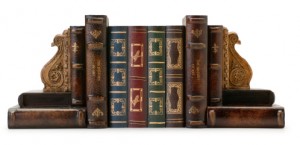Category: For Historical Fiction Fans
Mr. Darcy: Freestyle Disco Champion of All Derbyshire
Here is a touch of historical humor as we head into the weekend. Those of us on the east coast in particular could use a little levity as Irene bears down on us with all her predicted damage and inconvenience. So have a laugh or two before the power goes out. I do believe Jane Austen herself would get a chuckle out of this one.
Sunday Funnies: Henry VIII Meets the “Sassy Gay Friend”
“If I did that there’d be nothing but a bunch of necks working at the DMV” — truer words than that have never been spoke
Black Rats, the Black Death, and the Changeability of History
What we “know” for certain in history often changes. New studies, new information, new scholarship can challenge and change accepted facts, and undercut theories that have stood for decades or even longer.
Witness this article in today’s Guardian newspaper reporting that a new work by a well known archaeologist declares the Plague of 1348-49 spread so quickly through London that the carriers were not black rats, as previously thought, but human beings themselves. Fascinating and a reminder that we ought not be too sanguine about what we know to be “the truth.”
For All the Other Ladies Out There Who Hate “Casual Friday”
They don’t make men like they used to – heck they don’t even dress em like they used to. Sigh. Here’s a video worth salivating over, gentlemen dressed to impress. And by the way boys—if any men are reading this—any woman who tells you she likes “Casual Fridays” is lying.
Historical Fiction Coming Attractions
Location, Location, Location — Thoughts on the Use of Genuine Locations in Historical Fiction
My dear friend historical romance author Miranda Neville wrote an interesting piece at The Ballroom blog. The gist of Miranda’s post is that writers have an incredible collection of historical real-estate to browse when creating settings for their historical novels (whether straight or romance), and at each location we can cherry-pick the very best parts and amalgamate them into something new. For example, Miranda incorporated The Marble Saloon at Stowe into the fictional Mandeville House—setting for her just released The Amorous Education of Celia Seaton as well as two of her other romances.
Miranda’s post got me thinking about several additional points relevant to historical settings—specifically, pertaining to the use of real locations rather than locations created in the mind of the writer.
Timing is everything! Great cities, great cathedrals, and houses (both great and not so great) change over time. When an actual historical location is used in a novel we need to remember that—however iconic—that setting was not stagnant. Whether you are describing the skyline of Avignon or Westminster Abbey you’d better know what period you are writing about before you begin waxing wane with descriptions. And as a reader, you shouldn’t be too quick to expect certain locations to look certain ways (e.g., as they did when you visited, or in Aunt Irma’s postcards).
For example, Westminster Abbey is a true historic landmark. Millions have visited it, and many more have seen it in pictures or movies. What they’ve seen—and the images that rise to their minds when the Abbey is mentioned—is not the Abbey that existed when Eleanor of Provence was crowned Queen of England there in 1236. In fact, Eleanor’s husband, Henry III, was responsible for a masterful renovation of the Abbey (leaving it dramatically changed for generations to admire), a reconstruction that took years. As a result, the Abbey would have looked very different at various points in my novel, The Sister Queens.
Similarly, for much of its history (and today) the outline of the city of Avignon has been distinguished by the Papal Palace (gorgeous). But at the time of my novel, when Avignon was part of the Count of Provence’s territories, the great medieval palace seen in paintings and photographs didn’t’ exist. Describe Avignon including the palace and get it wrong. Read expecting to see the palace and it won’t be there. This is why it’s a darn good thing that . . . .
Historical novels are NOT guidebooks. While it IS important not to be anachronistic when portraying settings—making certain not to include features in an exterior or interior that didn’t exist in a particular time period—it is okay not to flesh out every corner of a room or every façade of a palace. I certainly believe that an author needs to know the world of her novel in depth in order to move her characters through it convincingly, but, unless you are describing the maneuvers of troops in a battle, sharing too much detail is unnecessary. A little era-setting detail often goes a long way. Readers like to use their imaginations, or at least this one does. When an author throws in too much description just because she/he has the research to support it, or when I feel he/she is showing me miniscule detail gratuitously (the details themselves are interesting or intriguing but in no way relate to the plot), I start to skim. Skimming is bad.
Of course there ARE occasions when an infusion of detail can enrich the reader’s experience. This is particularly true when we want readers to share the sensory experiences of a character—a young woman overwhelmed by the view from a chateau, or nearly dizzied by the incense-saturated air and soaring voices singing the Laudes Regiae in a magnificent abbey. Nothing can draw a reader into the emotion of a moment more effectively than the purposeful inclusion of carefully selected details of the historical setting. But note that I said, “purposeful inclusion” and “carefully selected.” Filtering is a must. Try to load the same level of detail into every scene in your historical novel and you ruin the effect.
Writers can also use setting itself as catalyst to move a scene forward. Of course on the large scale this fact is obvious—pick any scene in a historical novel and move the setting as a form of exercise (from the gardens of a grand Château to its great hall). The meaning of and physical movements in the scene are likely to change, even if you attempt to keep the dialogue the same. But, setting as catalyst can also occur in small subtle ways in fiction as it does in real life. Have you ever noticed something—on your desk, outside your window—that, serendipitously, makes your mind leap to a new place and to a particular idea or to action? That can happen to characters too. A mother picks up a bird’s nest and thinks of her children. The pattern in a window reminds a character of a gown and thus of a particular partner from the ball the evening before. I find as a writer I often want, even need, to place a certain scene in a certain setting in order to take advantage of elements of the architecture or décor that I know by my research would have existed in that place at that time.
What about you? As a writer how do you handle the REAL real-estate that makes an appearance in your work? As a reader how much detail is enough to make you feel immersed in the past? Where does the amount of detail cross a line, leaving you bogged down? Do you have strong feelings about the balance between real settings/descriptions based on research and locations/rooms created in the mind of the author?
Give Me A Little Kiss – Sex and the Historical Novelist
There is nothing new about sex. Birds do it, bees do it, and our ancestors most certainly did it (to butcher Cole Porter’s lyrics inexcusably).
What IS relatively new is the amount of sex appearing in “straight” historical fiction (I use this term to distinguish historical fiction from historical romance, not to imply that only heterosexual hanky-panky is included). If memory serves, the historical novels of my youth did a lot of fading-to-black. But somewhere between my decision to become a writer and my first book deal a shift occurred. Today there are plenty of sex scenes in straight historicals—some of them quite explicit. And sex seems to be a popular addition. For example, a video recorded at this year’s Historical Novel Society Conference during a popular event called “Late-Night Sex Scene Readings” (the reading of a scene from Gillian Bagwell’s The Darling Strumpet) has received over 6,000 hits on youtube since June.
Opinions on this trend vary. Here is mine: the inclusion of sex in historical novels is neither good nor bad in a vacuum. It’s not the sexual content that determines whether a particular scene works—it’s whether that scene (sex or otherwise) has a REASON for being in the novel. Tossing in an orgy (or even a kiss) into your work of historical fiction without a solid reason is a bad idea. The scene will feel “added on,” and gratuitous sex is no more acceptable in a novel than gratuitous dialogue.
So what can intimate scenes sometimes do well?
Forward the plot. Yep, just like any other sort of action a sex scene can move a novel’s plot forward. For example, one of my manuscripts includes the seduction of a royal courier for the purpose of getting a letter into his satchel. This letter is an important step on the path to the book’s central climax. So the sex scene (in a stable and pretty exciting in its own right, I might add) is vital to the forward motion of the novel.
Flesh out (sorry, I just HAD to) relationships between characters and/or give us emotional insights into characters. Sex, as we know from real life (or at least some of us know – no pressure on or disrespect to celibates reading this), is seldom merely a physical act. It has emotional ramifications, and can be a language all its own. So, a sex scene in a novel (whether vague or graphic) can be effectively used to give readers a sense of how characters relate to each other. For example, in my debut novel, The Sister Queens, readers learn a tremendous amount about one of my female characters and her relationships with two separate men simply by the contrast between her sexual experiences with each.
Help set the story firmly in its historical period. Sexual politics, mores, and practices change over time. For example, in certain periods, a man’s dominion over his wife’s body was complete – there was no such thing as rape between a man and his wife. Likewise, for hundreds of years sex (seduction, withholding of, etc) was one of the few tools available to a woman seeking power or influence. While today we would surely condemn a man for taking his wife by force and likely censure a woman for using sex to get ahead, seeing either such event a depicted in a historical novel reminds readers of the realities of the past and of our characters’ lives.
Beyond raising large issues of this sort, the inclusion of period details pertaining to sex—the acceptable positions for intercourse, its prohibition on certain days, the forms of birth control that were or were not available—can help build the “historical world” of the novel just as the inclusion of other period details can. In my novel frequent reference is made to payment of the “marriage debt,” and one of my female protagonists feels wronged when her husband spurns intercourse with her. As a matter of history she was entitled to feel gypped because, under the doctrine of the medieval Church, a married man was obliged, under penalty of mortal sin, to give his wife sex as a preventative measure against temptation to sins like fornication and adultery.
Give the reader a thrill. Yep, this one is legitimate too. But wait, Sophie, you are thinking, “you wrote five paragraphs ago that gratuitous sex is not acceptable.” Since when, dear writer, is giving the reader a bit of fun gratuitous? Meeting the needs of the reader is our business. We meet needs for escape. We meet emotional needs. We help readers wrestle with difficult questions in their lives. For heaven’s sake why should meeting readers’ needs for a bit of titillation be off the table? And why should meeting that need be solely the province of historical romance? Plenty of contemporary novels—from thrillers to literary fiction—include sex. I believe that writers working anywhere along the historical genre continuum should feel free to include intimate moments as well.
What do you think? Would you prefer to see explicit sex kept for historical romances alone? Can the inclusion of sex in a straight historical novels can be a positive addition?
Invention is the Midwife of Good Historical Fiction
Necessity may be the mother of invention, but invention is the midwife of good historical fiction.
Invention and creativity are good things. But in historical fiction we (writers) sometimes lose sight of that, and get bogged down in the minutiae of our period and the thousand little details in our characters’ lives. I was recently reminded, with force, that readers come to authors of historical fiction for something more than a collection of facts.
I had the opportunity to hear Susan Vreeland, a master of the genre, speak at a recent Historical Novel Society Conference. I thought Susan was going to do a presentation on her latest book. But, when we were gathered before her in our neat little rows, she decided to tackle a larger issue – the role of invention in historical fiction.
“Don’t be tyrannized by fact.” That’s how Susan opened her presentation. And she is right of course. Historical fiction is not academic history. Does accuracy matter in historical novels? You bet your farthingale it does but, “fictional art can show truth that goes deeper than a collection of fact; it can show us what it felt like to be a particular person at a particular time” (again, Susan V). Besides, “as soon as something happens people start lying about it” (Cecelia Holland) so “truth” in history can legitimately be debated.
Susan pointed out that selection (and correspondingly, elimination) of facts is part of the process of writing compelling historical fiction. Good authors know instinctively – whether they write historical fiction or another genre – that telling just the right bits is what gives a great story its focus. Authors of historical novels must choose only those events from history that relate to the specific premise/themes of their particular novel. It doesn’t matter how interesting an event is (or how pivotal it is in the life of a historical character), if that event doesn’t forward the plot of the book an author is writing, then it needs to be left out. There were dozens of interesting events in the lives of my main characters, Marguerite and Eleanor of Provence, during the twenty-year period covered by The Sister Queens that did not make it into my novel because they were not germane to the “sisters” theme of my book. Continue reading Invention is the Midwife of Good Historical Fiction

